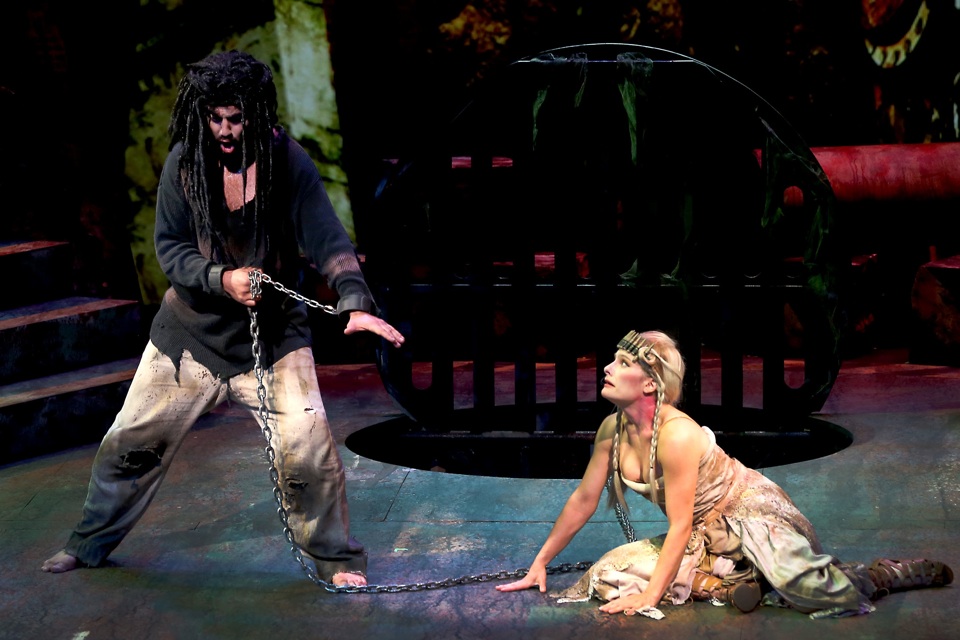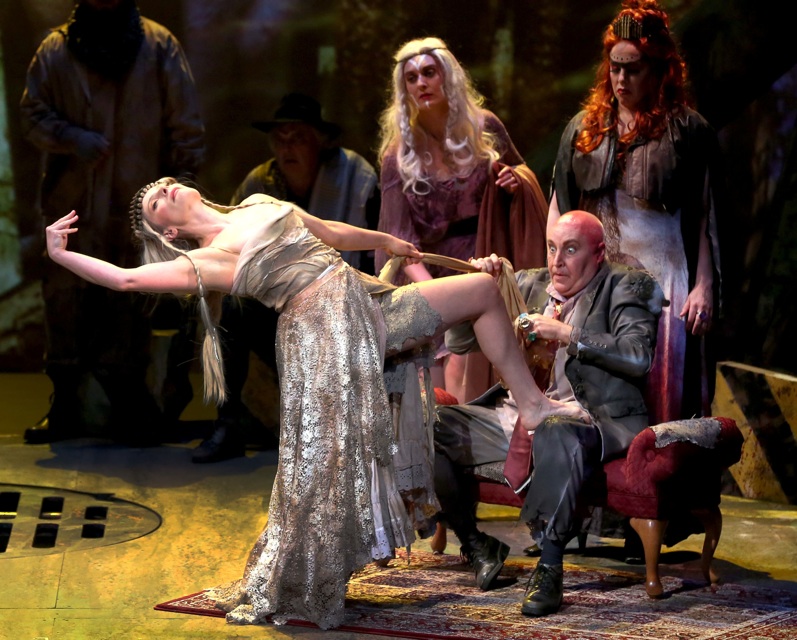A Femme very Fatale in Palo Alto
West Bay Opera took a dangerous concept and ran with it this past Saturday, June 3, at the Lucie Stern Theater in Palo Alto. Salome, the opera by Richard Strauss based on the play by Oscar Wilde, was loosely derived from a cautionary Biblical tale of debauchery, politics and the death of a saint. Conductor José Luis Moscovich and Director Ragnar Conde joined forces together with Mexico City’s Escenia Ensamble for a production that was properly shocking.
This is a Big Opera, a vehicle that can titillate the audience while preaching against human selfishness. To meet its musical demands, Moscovich took an outstanding cast and doubled the orchestra, squeezing extra strings into the pit and arraying the winds and brass on one side of the stage in two tiers, where they could still see him conducting from the pit. That full orchestra was able to display the exquisiteness of Strauss’ score, from the hair-raising harmonies of Divine prophecy to the confusing savagery of Herod’s court and the predatory sensuality of a teen heartthrob. The strings were lush with late Romantic yearning, the horns built to outsized Wagnerian questions, and the winds sharply exclaimed and caricatured, and all were colored with a tincture of early twentieth century experimentalism. (And still experimental to many in the audience.)
The tale was just as dense. Wilde’s adaptation was no “boy meets girl” plot. Try instead, “King lusts after his daughter, daughter falls in love with saint, saint rejects her, daughter gets head of saint… on a silver platter… and kisses it.”
 Strauss fitted his score to a story that held deep implications for his time, the pre-World War I era of industrialization and concurrent poverty. Opening in 1905 and causing a scandal, Strauss’ grotesquery was meant to convey a message on the poisonous effects of selfishness and short-term gains. Like John the Baptist, his was a “voice in the wilderness,” and not enough to stem the rise of German Nationalism or war.
Strauss fitted his score to a story that held deep implications for his time, the pre-World War I era of industrialization and concurrent poverty. Opening in 1905 and causing a scandal, Strauss’ grotesquery was meant to convey a message on the poisonous effects of selfishness and short-term gains. Like John the Baptist, his was a “voice in the wilderness,” and not enough to stem the rise of German Nationalism or war.
Driving the action was an unbridled Salome and an arresting John the Baptist, or Iokanaan. Heather Green, a silken lyric soprano with a big sound and luscious top notes played Salome to the nines. Not only did she throw herself into the meaty arias of this demanding opera, but also she inhabited mood swings from pretty and pouty to rolling around on the palace floor licking the blood off her lips (not her blood). To top that, she actually danced the Dance of the Seven Veils, instead of having a dancer stand-in, and did so with a slow otherworldly grace that mesmerized the audience.
Isaiah Musik-Ayala was an austere and forbidding John the Baptist, imprisoned in the cistern under the stage floor. His deep and reverberant voice rose up to send shivers down our spines, singing of prophecies that rumbled tattered poetry over the tangled threads of the music.
And completing the triangle was tenor David Gustafson, who was almost too convincing as Herod, Tetrarch of Galilee. His aria, “Salome, come drink wine with me” was gut twisting. I have heard Gustafson as lover and poet, but this was special. When he was not leering at his daughter, Salome, he was stumbling against a wind no one else could feel. “I hear the beating of vast wings,” he complained, and then tore the wig off his head and threw it down to cool his fevered brain. Edgy directing! I truly feared he would come down into the audience and order us to dance for him.
The moon loomed across the backdrop, almost a character of its own and a canvas for the projections of the players (and all of the video backdrops by Frédéric O. Boulay were mythic art). “How good it is to see the moon,” sang Salome. “She is like a little silver flower, cold and chaste… she has a virgin’s beauty.”
“The moon looks odd tonight,” crooned Herod later, “like a madwoman who seeks for lovers everywhere.”
“No, it’s just the moon,” replied Herodias, his wife. “Go in. You are ill.” Michelle Rice sang that mezzo-soprano role, wounded and shrill.
Salome agrees to dance for her father in order to get back at the chained prophet, both for her own hurt pride and for his pronouncements against her mother. And here Strauss gave us Middle Eastern textures and gorgeous oboe solos. When she demands the head of Iokanaan on a silver platter, her low notes were almost sprechstimme, growled speech-singing that accentuated the disquieting texts. “Thy mouth is like a sweet pomegranate cut with a knife of ivory,” she earlier sang. Her final aria to the bloody head was all heavy lifting, brilliantly done.
The cast was rounded out with a number of supporting roles, all first class, including Mexican tenor Alonso Sicairos León, whose voice was dramatic and earthy, and mezzo Veronica Jensen as the Page, baritone Kiril Havezov as the First Soldier and tenor James Callon as the First Jew. (Yep. 1905 Germany.)
And did we get the message?
The excellent production team brought this vision into focus. Peter Crompton’s post-apocalyptic sets of concrete barriers and mysterious cooling pipes and Abra Berman’s military costumes and radiation wands let us imagine the parallels between Herod’s time and 1905 Germany and now. It seems that we are cycling back to a time of grotesquery, a time of paranoid tweets and bigotry and the fall of the middle class. The halt and the lame are losing their Medicare and we are giving burnt offerings of coal. Now the oceans will rise and the dry lands turn to desert. Herod is in the house.
—Adam Broner
Photo, top: Isaiah Musik-Ayala (Iokanaan), Heather Green (Salome); photo by Otak Jump. Photo, below: Heather Green and David Gustafson (Herod), foreground; Katherine Naegele (Lady in Waiting), Michelle Rice (Herodias), standing; photo by Otak Jump.

